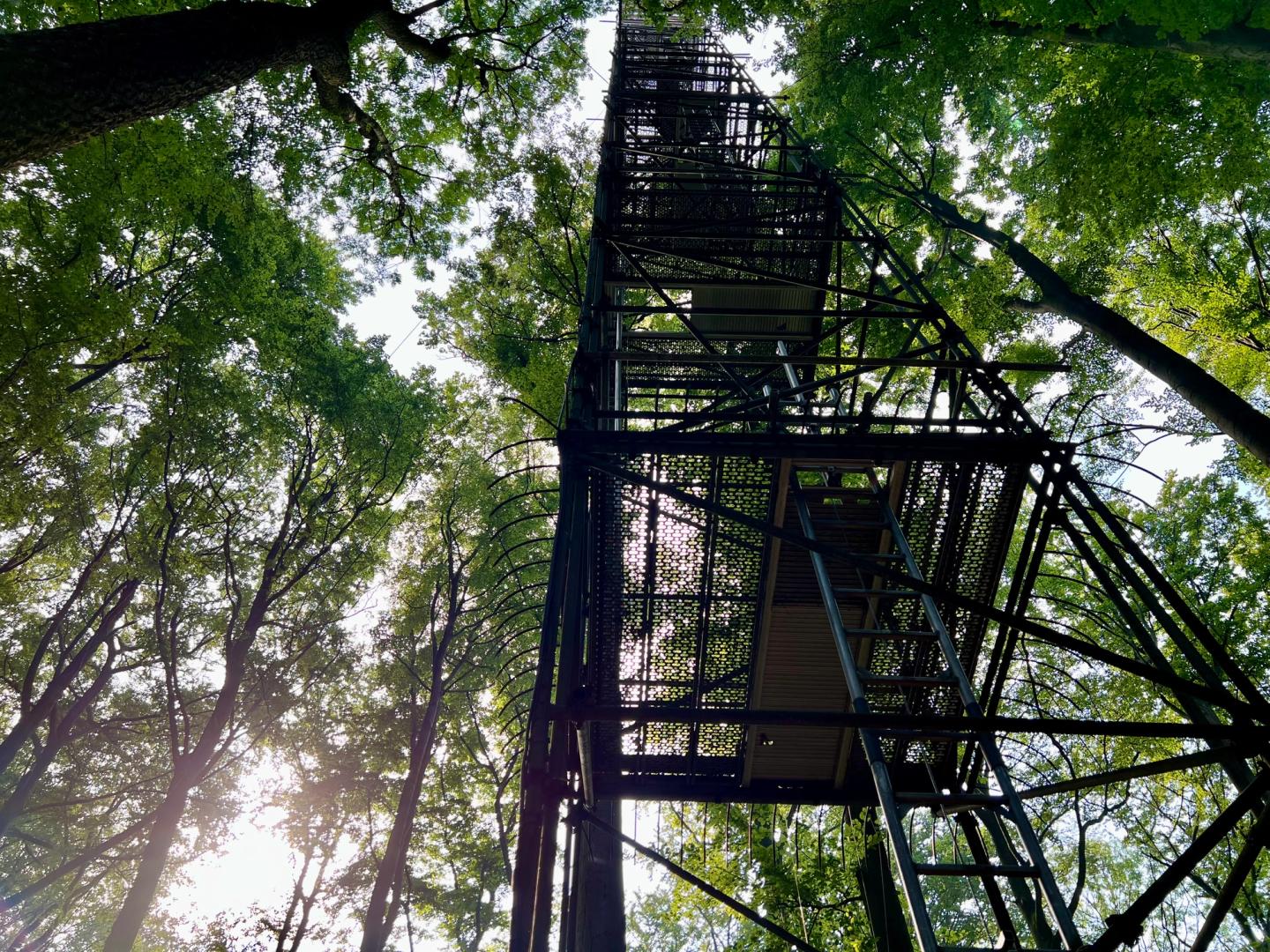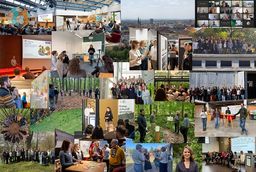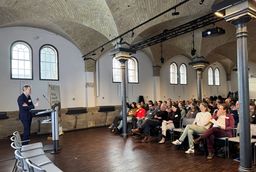What makes forests resilient?
- November 8, 2024
- 8 min. Reading time

Trees are struggling as a result of the increasing frequency of extreme climate events. Prolonged drought and heat in particular can cause entire forests to die. However, some forests are better able to cope with climate stress and are therefore more climate resilient than others. The Climate Future Lab ‘FoResLab’ wants to investigate the properties that make these forests resilient and use the results to make other forests in Lower Saxony climate-resilient. In this interview, FoResLab spokesperson Prof. Alexander Knohl introduces the Future Lab and explains the role of digital twins in the project.
Hello Prof Knohl, what does FoResLab want to research?
FoResLab is concerned with the question of how we can make forests resilient to climate change-related disturbances, both now and in the future.
The background to the question is that in recent years, namely 2018, 2019, 2020 and 2022, we have experienced a series of extreme climatic events, the effects of which we are currently seeing in the Harz Mountains, for example. Large areas of spruce forest are dying. But beech forests are also showing effects of extreme climatic conditions. Until now, beeches were considered a climate-future-proof tree species.
We therefore want to understand how these extreme climate events affect forests and which tree functions have changed. A major focus here will be on the water and carbon balance of the trees. It is particularly interesting that forests are affected by climate change on the one hand, and on the other hand are an instrument for mitigating climate change because they bind the greenhouse gas carbon dioxide (CO2), for example.
We are setting up three platforms for this purpose: firstly, an experimental platform where we will carry out measurements at forest sites; secondly, a digital platform consisting of a digital twin and an online forest stress monitor; and thirdly, a societal platform involving relevant stakeholders.
What made the years mentioned so challenging for forests?
2018 was the warmest year on record and one of the driest years since climate records began. This combination of drought and heat causes stress for plants. The lack of water due to low precipitation and high temperatures in summer depleted the water stored in the soil early on. As a result, drought stress sets in during the summer. If we look at the long-term measurements of CO2 uptake and water consumption by trees and compare them to 2003, the other ‘big’ dry year, we see that the trees showed drought stress reactions as early as June and then consistently until September.
What do these drought stress reactions look like?
Physiologically, the plants first start to close the stomata [Editor's note: the pores in the leaves] when they have too little water. This is a strategy to save water. As a result, less CO2 is absorbed, since both water and CO2 are exchanged through the stomata. If CO2 can no longer be absorbed, then no assimilates can be produced. This means that there is less growth and fewer reserves are built up. Due to the water stress, spruce trees in particular were unable to protect themselves against insects such as the bark beetle. This has led to the mass spread of the bark beetle and thus, among other things, to the large-scale death of trees in the resin.
Do you already have measurement locations in mind?
We plan to set up six locations where we will establish or further develop monitoring systems. Some of the locations are already involved in long-term monitoring activities by the Northwest German Forest Research Institute. We also use sites where my working group has been conducting eddy covariance measurements as part of global networks for more than 20 years [editor's note: atmospheric measurement technology for measuring and calculating vertical turbulent flows in atmospheric boundary layers].
The data is then merged with remote sensing and satellite data. With the help of these data, we are trying to assess the resilience of forests to climate extremes throughout Lower Saxony. We therefore have six very intensively measured locations where we can look at physiological processes in detail. The data from these locations are then used to validate our remote sensing data. We make targeted use of technological developments in recent years that now allow us to observe processes in forests almost in real time.
What does remote sensing mean in this context?
In this case, remote sensing refers to the recording of forest stands from a distance. In our case, this involves flying over an entire forest area by plane to take laser scans. At a slightly smaller scale, we will use drones to measure certain properties, such as surface temperatures, in smaller forest sections. In addition, we use satellite data to derive parameters that give us information about the vegetation status, water consumption and surface temperature.
How are the indicators to be interpreted?
One indicator would be how well a forest can deal with drought and still continue to function physiologically and return to its original behaviour after the drought. When a dry phase occurs, there may be forests, for example, that react very strongly to the drought and may show an increased mortality rate among trees. That wouldn't be resilient. A forest that manages to downregulate during dry periods but then returns to normal would be more resilient.
Are there plants that are already known to be particularly resilient?
That is part of the current research being conducted by various working groups worldwide. We have already seen that pure spruce forests, i.e. monocultures, have great difficulties with drought stress. It is therefore more appropriate to conduct research in the direction of mixed forests. In addition to the diversity of the tree species themselves, i.e. how many different tree species the forest consists of, the diversity of the forest structures probably also plays a major role. To investigate this, we have selected forest sites as measuring locations that have both a high structural diversity and a diverse composition of tree species.
The hypothesis as to why such forests are more successful is that the diversity of species and structures allows better use of different ecological niches. For example, trees with deeper roots are found next to trees with shallower roots. They are therefore complementary and can make better use of available resources in stressful situations.
In this case, structural diversity refers to diversity in terms of external characteristics such as plant age, growth height, distribution of branches in the crown space, root depth, etc. In a forest with trees of different ages, for example, the treetops are also at different heights. If a stress event then occurs, some of these trees are more exposed to the sun and others less, which means that not all trees react the same way and thus the risk of damage is spread.
The measurement data is then transferred to a digital twin. What does this mean?
A digital twin is a simulation model that represents a real forest. We want to use it to combine the measurement data from our study areas. On the one hand, the data from the real-time measurements that we collect in our six instrumented forests and, on the other hand, the data on forest structure that we collect with laser scans from the ground and from the air.
This model is ultimately a forest growth model into which new measurement data is constantly being fed. In this way, the model learns from current observations and creates a digital twin. Scenarios can then be tried out on this twin. For example, what would happen if we changed the forest structure? What would happen if we promoted certain tree species more and others less? What would happen in a particularly hot and dry climate? What would happen in a climate where we meet the 2.0 degree target, i.e. where there are fewer extreme events, compared to a worst-case scenario.
Historical data from the last 20 years is used as input to calibrate and validate the model. The model needs these parameters to learn how the forest has responded to different climatic conditions in the past.
What is the societal platform about?
The societal platform is about working closely with relevant forest stakeholders to understand which social and economic aspects are important for designing resilient forests. In particular, we will be working closely with our partners Niedersächsische Landesforsten, the Harz and Hainich National Parks and the Stiftung Zukunft Wald, who are developing school forests together with schools. In one sub-project, we want to use interviews, among other things, to investigate what demands are placed on the forest and which measures for building resilience are accepted. Our hypothesis here is that the establishment of more diverse and structured forests will also lead to greater acceptance in society. In addition, science communication will play a central role. In a sub-project, the Forum Wissen, the knowledge museum of the University of Göttingen, will develop an online learning module for school classes, which will allow students to take on the role of different actors and participate in the design of the forests. Together with the Lower Saxony Academy of Sciences in Göttingen, we will discuss the topic of forests and society from different perspectives in public events.
What will the first steps be in the Climate Future Lab? What will the start of the research work look like?
First of all, we as the Climate Future Lab will lay the foundations for our later research work. Currently, this means that we are hiring young scientists who will research and work with us in the Future Lab over the next few years. In addition, we will need to take our partner network with us in our development.
As for the actual research work, we will start by building our infrastructure and conducting initial interviews with stakeholders. Later on, we will add the evaluation of the data collected, and so we will implement the project step by step.
It will be an exciting challenge to combine the scientific perspective, i.e. measuring, quantifying and evaluating resilience, with the demands and preferences of society with regard to forests. Combining the two is an exciting goal. We at the Climate Future Lab are looking forward to exploring these aspects together.
Thank you for the interview.
Contact

More Posts
All
2025 Year in Review – The ZKfN Year in Pictures
2025 was marked by the expansion of the Climate Future Labs, new collaborations and a more closely networked climate community in Lower Saxony.
5 min. Reading time
How collaboration across disciplinary boundaries works
The workshop at the ZKfN symposium showed the prerequisites for interdisciplinary and transdisciplinary collaboration and the added value it creates.
3 min. Reading time
Connecting perspectives - impulses for a just climate future
Review of our "Symposium Climate Future Lower Saxony" 2025
3 min. Reading time